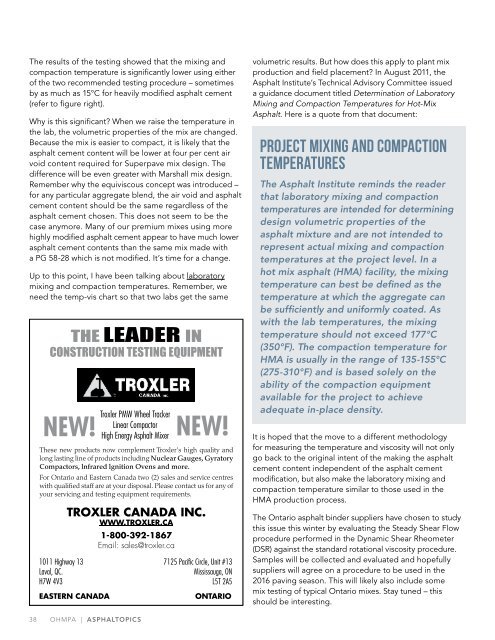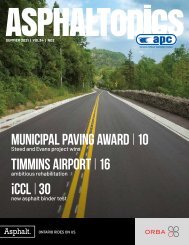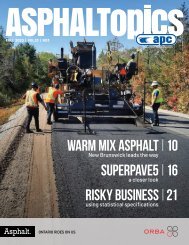ASPHALTopics | Fall 2015 | VOL 28 | NO 3
You also want an ePaper? Increase the reach of your titles
YUMPU automatically turns print PDFs into web optimized ePapers that Google loves.
The results of the testing showed that the mixing and<br />
compaction temperature is significantly lower using either<br />
of the two recommended testing procedure – sometimes<br />
by as much as 15°C for heavily modified asphalt cement<br />
(refer to figure right).<br />
Why is this significant? When we raise the temperature in<br />
the lab, the volumetric properties of the mix are changed.<br />
Because the mix is easier to compact, it is likely that the<br />
asphalt cement content will be lower at four per cent air<br />
void content required for Superpave mix design. The<br />
difference will be even greater with Marshall mix design.<br />
Remember why the equiviscous concept was introduced –<br />
for any particular aggregate blend, the air void and asphalt<br />
cement content should be the same regardless of the<br />
asphalt cement chosen. This does not seem to be the<br />
case anymore. Many of our premium mixes using more<br />
highly modified asphalt cement appear to have much lower<br />
asphalt cement contents than the same mix made with<br />
a PG 58-<strong>28</strong> which is not modified. It’s time for a change.<br />
Up to this point, I have been talking about laboratory<br />
mixing and compaction temperatures. Remember, we<br />
need the temp-vis chart so that two labs get the same<br />
volumetric results. But how does this apply to plant mix<br />
production and field placement? In August 2011, the<br />
Asphalt Institute’s Technical Advisory Committee issued<br />
a guidance document titled Determination of Laboratory<br />
Mixing and Compaction Temperatures for Hot-Mix<br />
Asphalt. Here is a quote from that document:<br />
PROJECT MIXING AND COMPACTION<br />
TEMPERATURES<br />
The Asphalt Institute reminds the reader<br />
that laboratory mixing and compaction<br />
temperatures are intended for determining<br />
design volumetric properties of the<br />
asphalt mixture and are not intended to<br />
represent actual mixing and compaction<br />
temperatures at the project level. In a<br />
hot mix asphalt (HMA) facility, the mixing<br />
temperature can best be defined as the<br />
temperature at which the aggregate can<br />
be sufficiently and uniformly coated. As<br />
with the lab temperatures, the mixing<br />
temperature should not exceed 177°C<br />
(350°F). The compaction temperature for<br />
HMA is usually in the range of 135-155°C<br />
(275-310°F) and is based solely on the<br />
ability of the compaction equipment<br />
available for the project to achieve<br />
adequate in-place density.<br />
It is hoped that the move to a different methodology<br />
for measuring the temperature and viscosity will not only<br />
go back to the original intent of the making the asphalt<br />
cement content independent of the asphalt cement<br />
modification, but also make the laboratory mixing and<br />
compaction temperature similar to those used in the<br />
HMA production process.<br />
The Ontario asphalt binder suppliers have chosen to study<br />
this issue this winter by evaluating the Steady Shear Flow<br />
procedure performed in the Dynamic Shear Rheometer<br />
(DSR) against the standard rotational viscosity procedure.<br />
Samples will be collected and evaluated and hopefully<br />
suppliers will agree on a procedure to be used in the<br />
2016 paving season. This will likely also include some<br />
mix testing of typical Ontario mixes. Stay tuned – this<br />
should be interesting.<br />
38 OHMPA | ASPHALTOPICS


















